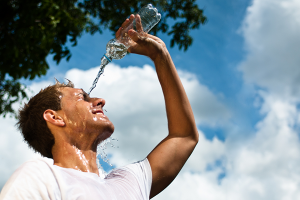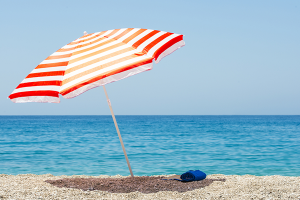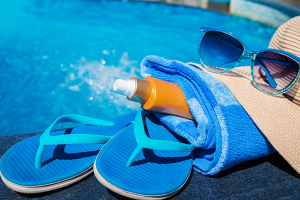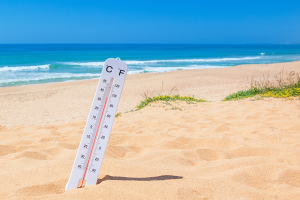Following the inevitable melt down of “Lucifer” over the next few weeks, violent electrical storms are predicted: these may well give rise to a further period of excessively hot weather in the UK.
But today, hundreds of thousands of cold, damp, pink Brits will be stripping off on the beaches of southern Europe to broil in ferocious and alien oven heat. A hundred years ago, they would have been cowering behind closed shutters, girls only venturing out beneath their parasols – all clinging to the coolest, deepest shade. Napoleon had lined his marching roads with avenues of close set, lofty trees: he valued his soldiers.
Following the rise and rise of budget airlines, heat related illnesses are becoming commonplace but not necessarily well-recognised.
Heat stress is caused by increased air temperature, and exacerbated by humidity and internal metabolic heat generated by exercise. As the ambient temperature rises, the body becomes much more dependent upon the evaporative cooling of sweat. Evaporation is reduced by humidity, inappropriate clothing and low air movement.
Additional sweating is enabled by a greatly increased blood flow to the skin. The loss of body fluids to sweat can lead to dehydration and the consequent reduction of circulating blood volume and an increase in its viscosity. The strain on the heart, an uncontrolled rise in core temperature, and the release of damaging inflammatory chemicals (cytokines) from over-heated tissues can cause the potentially lethal heat stroke.
The normal body temperature is regulated at around 37℃ (98.4 ℉), within + 1℃ (maximum 100.4℉). The control mechanisms for the maintenance of a healthy core temperature can be quickly overwhelmed by a sudden rise in ambient temperature as caused by air travel or a heat wave. Acclimatization begins within four to six days, and is complete within two weeks – not quick enough for the average tourist.
The onset of heat stroke is marked by typical symptoms such as –
- High body temperature of around 40℃ (104℉)
- Altered mental state or behaviour – as in confusion, agitation, slurred speech, anger, irritability and rashness. These can proceed to delirium, seizures and coma.
- Nausea and vomiting
- Flushed skin
- Rapid breathing
- Rapid pulse rate
- Headache
- Muscle weakness or cramps
- Dizziness and light-headedness
- Lack of sweating
Anybody can develop heat stroke, but these are definite risk factors-
- Age – the young and the older generations are more vulnerable
- Obesity – fat is a good insulator preventing heat loss
- Alcohol – further dilates blood vessels and acts as a diuretic causing more loss of water in urine
- Strenuous exercise – generates internal heat
- Dehydration – insufficient fluid intake – drink anything (coffee and tea included) apart from alcohol
- Loss of salt in sweat, giving rise to low blood sodium – add salt to food
- Lack of fitness
- Febrile illness such as flu, any infectious disease
- Previous heat related illness
- Some medications, especially beta blockers, diuretics, antidepressants and antipsychotics and stimulants for ADHD (always ask your doctor)
- Inappropriate clothing – the less the better
- Illegal stimulants such as amphetamines and cocaine
- Sunburn!
On a hot holiday, look out for yourself and others (who might well be oblivious). Call for medical help if in any doubt. Whilst waiting, bring the person into air conditioning (at least shade), remove as many clothes as decent, and above all, cool the person down – a cool (not super cold) bath or shower, sponge with cool water, apply ice packs in towels to head, neck, armpits and groin. Please do not hesitate!
Of course do behave sensibly yourself and avoid obvious risks-
- Avoid full sunshine in the middle of the day
- Use hats, sun block, body cover, any sort of shade at other times
- Use showers and dips in the sea/pool frequently
- Drink lots of (any) fluid – adults 3 litres/day at least
- Avoid exertion during the heat of the day – climbing, serious walking, tennis, sight-seeing, whatever
- If you take regular medication, tell your doctor where you are going. He might need to adjust your regime to suit
- If you develop diarrhoea, drink more water along with dissolved Dioralyte to replace lost salts and Imodium (Loperamide) to slow down fluid loss (as instructed on the packet information sheets)
- If you also start to vomit frequently call for medical help
The best possible way of judging the adequacy of your fluid intake is by carefully watching the colour of your urine – if it starts to become deeper than a light “pale straw”, verging on “browny yellow”, you are significantly short of fluid.
PMID 24326903
PMID 23509213
www.mayoclinic.org/con – 20032814








